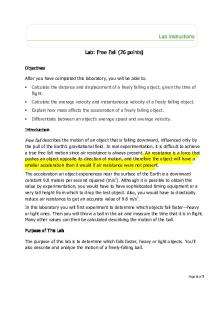Free fal lab reports - physics 1 lab report on free fall PDF

| Title | Free fal lab reports - physics 1 lab report on free fall |
|---|---|
| Course | LAB: Physics I |
| Institution | Fairleigh Dickinson University |
| Pages | 1 |
| File Size | 47.6 KB |
| File Type | |
| Total Downloads | 49 |
| Total Views | 156 |
Summary
physics 1 lab report on free fall...
Description
Free fall physics lab report Introduction In that lab, we measured the velocity and acceleration of an object as it falls towards the earth’s surface. A spark timer, attached to falling object, and left dots on paper tape at equal time intervals; these dots recorded the location of falling object at those times. We had to measure ten dots. To analyze each dot, I and my partner Julia gave number to all dots. Therefore, first we measure the distance between s0 to s1 and s1 to s2 like that till s9 to s10 with 0.05 second of time interval. After gathering all raw data Julia and I had to analysis the data to find the velocity, acceleration, and absolute deviation. So, we found velocity by using this equation(velocity=distance/time). After got all velocities we got the average of acceleration by using this equation (Acceleration= velocity/time). And we found absolute deviation from the equation that was given by professor. Result First, we got the Velocity from the total distance we got, and the time was given. Then we had to find acceleration from the velocity and time. So, average acceleration was 978.57 cm/ s 2 . Also, we got the absolute distance which was ± 27cm/ s 2 . Using our best data, we made a graph. We got the acceleration by slope of velocity vs time graph. After observing both velocity and time on the graph. I can see that my graph gave a liner line. I calculated percentage error between slope and accepted value of 980 cm/ s 2 which was 0.146 cm/ s 2 . Conclusion: When an object is in free fall, its acceleration is increasing at a constant rate, thus making the velocity increase at a constant rate. By comparing the obtained acceleration values with the constant value, we are able to account for the experimental errors....
Similar Free PDFs

Lab-Free Fall - Physics 1
- 7 Pages

Free Fall Motion Lab - lab
- 5 Pages

Motion in Free Fall Lab Report
- 3 Pages

Motion in Free-Fall Lab Report
- 13 Pages

Week 4 - FREE FALL - lab report
- 6 Pages

Lab 3 ( kinematic free fall)
- 11 Pages

Lab Reports physics
- 4 Pages

CN Lab Reports(1-5) - Lab Reports
- 12 Pages

LAB REPORT FREE AND FORCED VORTEX
- 14 Pages

Physics 1 - Lab Report 1
- 3 Pages

Physics Lab 4 - lab report
- 5 Pages
Popular Institutions
- Tinajero National High School - Annex
- Politeknik Caltex Riau
- Yokohama City University
- SGT University
- University of Al-Qadisiyah
- Divine Word College of Vigan
- Techniek College Rotterdam
- Universidade de Santiago
- Universiti Teknologi MARA Cawangan Johor Kampus Pasir Gudang
- Poltekkes Kemenkes Yogyakarta
- Baguio City National High School
- Colegio san marcos
- preparatoria uno
- Centro de Bachillerato Tecnológico Industrial y de Servicios No. 107
- Dalian Maritime University
- Quang Trung Secondary School
- Colegio Tecnológico en Informática
- Corporación Regional de Educación Superior
- Grupo CEDVA
- Dar Al Uloom University
- Centro de Estudios Preuniversitarios de la Universidad Nacional de Ingeniería
- 上智大学
- Aakash International School, Nuna Majara
- San Felipe Neri Catholic School
- Kang Chiao International School - New Taipei City
- Misamis Occidental National High School
- Institución Educativa Escuela Normal Juan Ladrilleros
- Kolehiyo ng Pantukan
- Batanes State College
- Instituto Continental
- Sekolah Menengah Kejuruan Kesehatan Kaltara (Tarakan)
- Colegio de La Inmaculada Concepcion - Cebu




